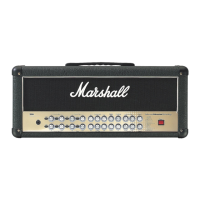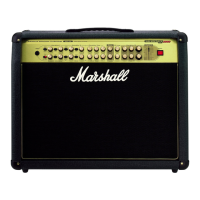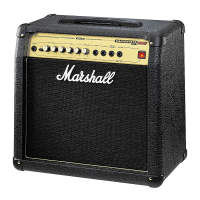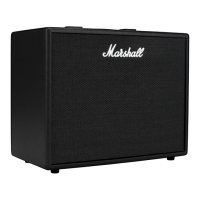ENGLISH
11
AVT100 Rear Panel Features
1 Mains Input Connector
Your AVT is provided with a detachable
mains (power) lead which is connected here.
The specific mains input voltage rating that
your amplifier has been built for is shown on
the back panel. Before connecting for the first
time, please ensure that your electricity supply
is compatible with your amplifier. If you have
any doubt, please seek advice from a qualified
technician. Your Marshall dealer will help in
this respect.
2 Loudspeaker Jack Sockets
There is one speaker jacksocket on the
AVT100, marked Internal (8 Ohm), this is
where the output of the AVT power amplifier is
connected to its internal 8 Ohm Celestion
loudspeaker.
WARNING:
Always provide the AVT100 with a load
equal to, or greater than, 8 Ohms.
3 Footswitch
For connection of the supplied Stage Foot
Controller (PEDL-00030). This sturdy 4-way
Marshall footswitch allows instant selection of
the 3 channels, plus the DFX. It also features
LED's to indicate status.
4 Headphone
The headphone output is fully emulated
using an improved version of the circuitry
found on the industry standard JMP-1.
Turning the Master Volume (16) to zero will
provide silent practice.
5 Emulated Line Output
This jack socket carries a specially
treated output signal from your AVT that
accurately emulates the sonic signature of a
Marshall 4x12 cabinet. This unerringly
accurate emulation circuitry is Marshall's most
advanced to date and was developed via
countless hours of technical research, playing,
listening and fine-tuning. This output can be
used in both live performance and recording
situations to achieve authentic guitar amp
tones, without having to use a microphone.
Turn down the Master Volume (16) for silent
recording.
FX Loop
As already mentioned, the AVT100 boasts
a Mono Parallel FX loop for connection with
external effects units. In addition to the FX Mix
control on the front panel (see ‘Front Panel
Features,’ point 18) this FX loop comprises of
an FX Send jack, an FX Return jack and an
FX level control button.
6 FX Return
For connection to the output of your
external effects device.
7 FX Level
This should be set to match the level of
the processor being used (generally -10dB for
a stomp box, + 4dB for a professional, rack
unit).
8 FX Send
For connection to the input of the external
device being used.
➲
FX Loop Hints
a) Always use high quality, shielded patch
cables.
b) If the processor being used has an
input level control, ensure it is set correctly.
c) Time based effects (delays & reverbs)
and modulation effects (chorus, flange, phase,
etc.) are ideal for use in a Parallel FX loop.
d) Certain stomp box effects such as
Wah, distortion, overdrive and fuzz were
designed specifically for use in-front of the
amp and sound best when used that way. This
said, tonal beauty is in the ears of the beholder
so, if such a pedal sounds great to you when
used in an FX loop then go for it! Sometimes,
there are no rules...
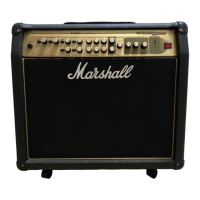
